 |
| LCD Screen Magnifiers |  |
When using a digital compact or live preview camera underwater, the LCD screen is sometimes the only available viewfinder. This creates a particular problem underwater for those who need reading glasses or bifocals; and it is conceivable that even those with good eyesight will benefit from something that makes the LCD easier to see. In the event that there is no purpose-built magnifier designed to attach to the underwater housing, this article offers some suggestions on the subject of LCD magnifiers and the general issues raised for divers who need glasses.
Prescription lenses
If you need glasses all the time, you should enquire at your local dive store about diving masks with prescription lenses. You might also consider using gas-permeable contact lenses, but in this case you suffer the risk (albeit one which many divers are prepared to take) that you might lose your lenses if you flood your mask. If you just need reading glasses however, or your normal prescription differs from you reading prescription, these solutions will be unsatisfactory, because you won't be able to focus on infinity with your reading lenses in place. For this situation, you need some kind of auxiliary magnifying glass, and the choice lies between placing a high-powered lens close to the screen, or a low-powered lens close to the eye, or an intermediate powered lens somewhere in between.
Magnifying glasses
The cheapest solution is to take a simple magnifying glass with you when you dive. It is a good idea however, to choose a magnifier with a glass lens. The difference in refractive index between the lens material and water is usually less with plastic than it is with glass, which means that a plastic lens will lose more of its magnifying power than will a glass one when immersed in water. A glass lens will still lose about 2/3 of its magnifying power, but may have enough left to be useful. You should also ensure that the magnifying glass you adopt has a plastic, aluminium, or plated-brass lensholder and handle not steel - check with a magnet), so that it will not corrode; and you should use a single-element lens so that water does not leak into any air-space or attack the bonding material between cemented elements.
A cheap Sherlock Holmes type magnifier, with a plastic holder, can be bought at a local market for about UK£1.50 (US$2). A crown-glass lens can be identified by the slight greenish tinge and the weight. The magnifying power can easily be estimated by focusing an image of a distant object onto a surface (caution, fire and burns hazard if you use the sun). The distance between the lens and the image is the focal length of the lens. The reciprocal of the focal length in metres is the power of the lens in diopters, e.g., if the focal length is about 0.33 m, the power is 1/0.33 = 3 diopters (fairly typical for magnifying glasses). Such a lens immersed in water will usually have a power of a little over 1 diopter (it depends on the type of glass), roughly equivalent to a typical reading-glass prescription when held close to the outside of your diving mask. A hole drilled in the handle will allow you to attach a lanyard and clip it to your buoyancy jacket.
The dissatisfaction with using a separate magnifying glass, is that it requires an extra hand in order to hold it. If you wear a helmet to carry torches, you might consider attaching the magnifier to the helmet and improvising a swivel-joint so that the lens can be flipped in front of the eye when needed. It all adds encumbrance however, and the best solution for LCD viewing is obviously to attach something to the housing.
Close-up lenses
If a lens is to be placed close to the housing, it must have a high magnifying power; and if this is to be achieved with a single piece of glass, a high degree of curvature is required. Such high-curvature lenses can be obtained by dismantling the condensers from old enlargers and projectors, but the point of this investigation was to find a solution involving commercially available items. The best candidates are large-aperture underwater close-up lenses such as the the INON UCL-165M67 or the UN PCU-01.
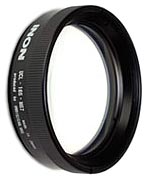 |
The UCL-165 is a two-element lens with a sealed intermediate air-space. Since most of the magnification is provided by the two internal glass-air boundaries, the lens retains most of its power when immersed in water. The power in air is +7.4 diopters, and the power underwater is +6 diopters. Other close-up lenses will work of course, but the viewing aperture of the INON lens is a very generous 52 mm, which makes it possible to us it as a highly effective long-eye-relief viewfinder. |
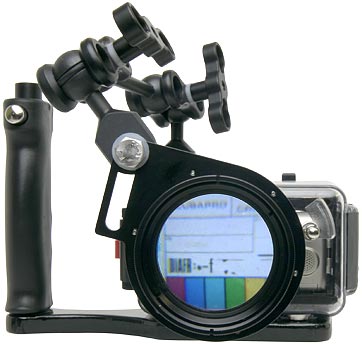 |
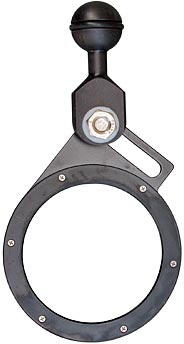 |
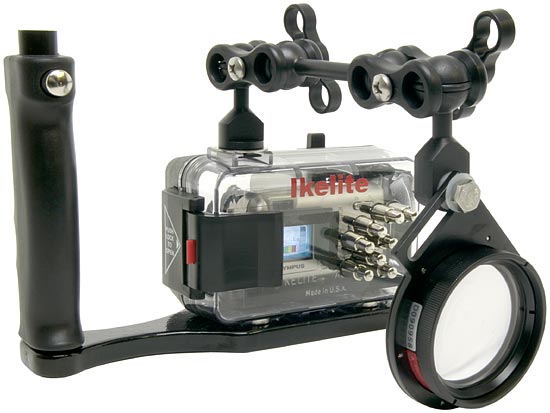
The author's reading glass prescription at the time of the test was +1.75 diopters. It was found that the UCL-165 lens gave optimum results when placed about 10 - 12 cm from the back of the housing and used with the eye fairly close to it. With this arrangement, it was possible to resolve the matrix of pixels in the LCD with excellent eye-relief, the experience being very much like using an SLR camera with an action-finder. The practical benefits of the magnifier were immediately obvious: these being an increase in speed of framing, elimination of composition errors, elimination of failed photographs due to inability to read menus and error messages, and elimination of fatigue due to eye-strain.
In the photographs above, the ball-arm on which the magnifier is mounted uses an Ultralight AD-HS accessory-shoe mount, and an Ultralight DB-03 (3" between ball centres) double-ball arm section . The clamps give a distance of 1.5" between ball centres, and so the distance from the centre of the accessory-shoe ball to the centre of the lensholder ball is 6" (about 15cm). This extreme extension of the arm is ideal for the author's eyesight; but more latitude of distance adjustment can be obtained by using the Ikelite #0466.42 double-ball arm section, which gives 4" between ball centres and hence allows an adjustment range of about 2 - 7" (5.1 - 17.8 cm). Since the focal length of the INON close-up lens is 165 mm, a distance of 16.5 cm from the mid-plane of the lens to the apparent position of the LCD will cause the viewfinder image to be sharp when the eye is focused at infinity, i.e., the extreme extension obtainable with the 4" double-ball is about right for those whose eyes have no accommodation at all.
The arrangement shown is, of course, only suitable for housings with an accessory shoe. In other cases it is possible to attach an auxiliary ball-mount to the tray, handle, or housing, and make up a ball arm suitable for the specific application. The point (if using the UCL-165) is to mount the lens somewhere between about 8 and 16.5 cm from the LCD screen. Additional articulation (another clamp and another double-ball section) may be needed in some situations.
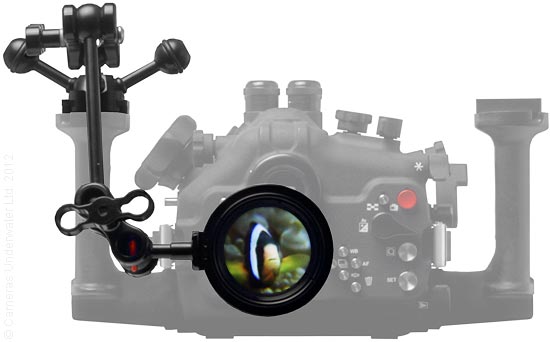
Magnifier using the Inon M67 lens arm.
 DWK DWK© David W Knight 2004-2011, 2018. |
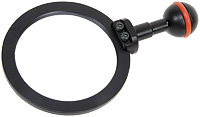 Inon M67 lens arm |